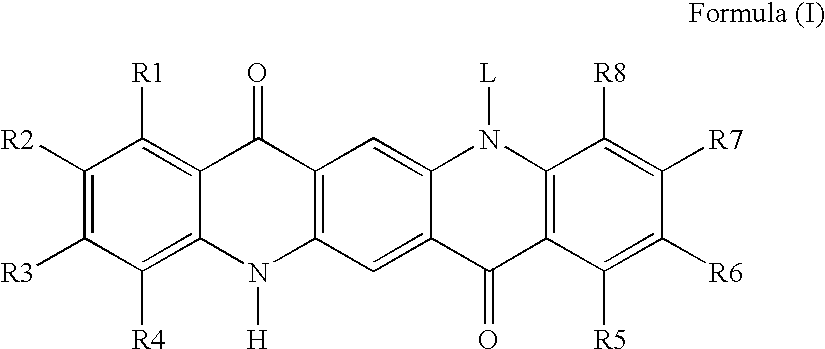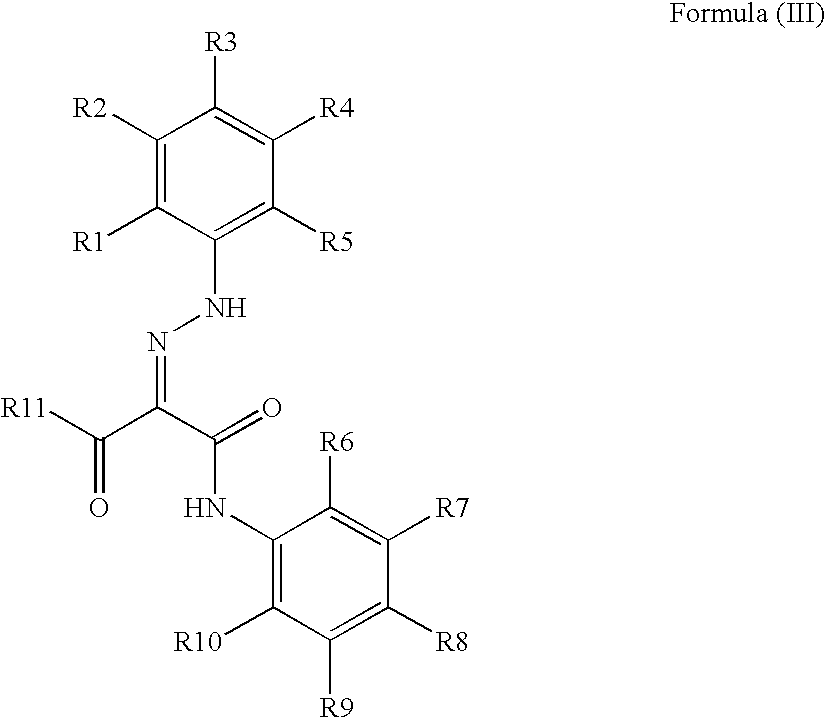Pigment Dispersions with Polymeric Dispersants Having Pending Chromophore Groups
a polymer dispersant and pigment dispersant technology, applied in the field of stable pigment dispersions and pigmented inkjet inks, can solve the problems of poor dispersion stability, dispersed pigment particles may have a tendency to re-agglomerate, and reduce the dispersing energy required, and achieve the effect of increasing the concentration of humectants
- Summary
- Abstract
- Description
- Claims
- Application Information
AI Technical Summary
Benefits of technology
Problems solved by technology
Method used
Image
Examples
example 1
[0244]This example illustrates that stable inkjet inks of different pigments can be prepared using the same polymeric dispersant having at most 30% of the monomer units of the polymeric backbone carrying a pending chromophore group. The polymeric backbone of the dispersant is a homopolymer, which is known to have poor dispersing capability.
[0245]Polymeric Dispersants DISP-1 to DISP-4
[0246]The polymeric dispersants DISP-1 to DISP-4 were prepared by copolymerizing a monomer MONC already containing a chromophore group.
[0247]Chromophore MC-2
[0248]The formation of the chromophore MC-2 was accomplished by diazotation of compound MC-1D and subsequent coupling in the compound MC-2B.
[0249]Preparation of Compound MC-1C
[0250]The vessel used to carry out this reaction was a 3 necked flask equipped with a stirrer, a cooler and a dropping-funnel. To a solution of 13.9 g (0.1 mol) 2-nitrophenol (compound MC-1A) in 100 mL dimethylformamide was added 31.8 g (0.3 mol) of sodiumcarbonate. The mixture ...
example 2
[0292]This example illustrates that inkjet inks of different pigments can be prepared with high dispersion quality using the same polymeric dispersant having at least 2% of the monomer units of the polymeric backbone carrying a pending chromophore group. The polymeric backbone of the dispersant is a alternating polymer, which is known to have poor dispersing capability.
[0293]Polymeric Dispersants DISP-7 to DISP-10
[0294]The alternating copolymer SMA 1000P was used as polymeric dispersant DISP-7 to prepare a comparative inkjet ink. DISP-7 was then used for preparing styrene maleic acid copolymers modified by chromophores MC-7 and MC-12.
[0295]Chromophore MC-7
[0296]The synthesis of the chromophore MC-7 will now be described.
[0297]Preparation of Chromophore MC-7
[0298]6.9 g (45.2 mmol) of compound MC-1D was mixed with 40 mL H2O and 10 mL methanol. Then, 4.5 g (54 mmol) of compound MC-1F was added and the mixture was stirred for 30 minutes. This is mixture A-MC-7. 5.8 g (45.2 mmol) of comp...
example 3
[0331]This example illustrates that a stable magenta inkjet ink of the pigment PR122 can be prepared using a polymeric dispersant having less than 30% of the monomer units of the polymeric backbone carrying a pending chromophore group. The polymeric backbone of the dispersant is a homopolymer, which is known to have poor dispersing capability.
[0332]Polymeric Dispersant DISP-11
[0333]The polymeric dispersant DISP-11 was prepared by modifying VERSICOL E5 (DISP-5) through esterification with the chromophore MAG-1.
[0334]The resulting pending chromophore group PM-1 was linked by N* to the polymeric backbone through a linking group L containing an ester bond.
[0335]Chromophore MAG-1
[0336]25 g (80 mmol) PV19 was suspended in 200 mL DMSO. 17.9 g (160 mmol) KOtBu was added and the suspension was heated to 70° C. 21.64 g (104 mmol) 2-(2-bromoethoxy)-tetrahydro-2H-pyran was added and the reaction was allowed to continue for 3 hours at 70° C. After cooling down to room temperature, 300 mL of wate...
PUM
| Property | Measurement | Unit |
|---|---|---|
| Fraction | aaaaa | aaaaa |
| Fraction | aaaaa | aaaaa |
| Fraction | aaaaa | aaaaa |
Abstract
Description
Claims
Application Information
 Login to View More
Login to View More - R&D
- Intellectual Property
- Life Sciences
- Materials
- Tech Scout
- Unparalleled Data Quality
- Higher Quality Content
- 60% Fewer Hallucinations
Browse by: Latest US Patents, China's latest patents, Technical Efficacy Thesaurus, Application Domain, Technology Topic, Popular Technical Reports.
© 2025 PatSnap. All rights reserved.Legal|Privacy policy|Modern Slavery Act Transparency Statement|Sitemap|About US| Contact US: help@patsnap.com



